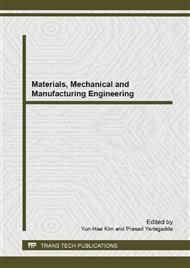[1]
L. Pouvreau, M.C. Jonathan, M.A. Kabel, S.W.A. Hinz, H. Gruppen, H. A. Schols: Enzyme and Microbial Technology Vol. 49 (2011), pp.312-320.
DOI: 10.1016/j.enzmictec.2011.05.010
Google Scholar
[2]
B. Fatima-Zohra, P. Catherine, H. Patrick: Carbohydrate Research Vol. 346(2011), pp.2896-2904.
Google Scholar
[3]
S. Daus, K. Petzold-Welcke, M. Kötteritzsch: Macromolecular Materials and Engineering Vol. 296(2011), pp.551-561.
DOI: 10.1002/mame.201000390
Google Scholar
[4]
M. Pinaki, A.P. Carlos, B.D. Elsa: International Journal of Biological Macromolecules Vol. 46(2010), pp.173-178.
Google Scholar
[5]
L.S. Audrey, J.M. Derek, S.L. Marc: Glycoconjugate Journal Vol. 15(1998), pp.697-712.
Google Scholar
[6]
K.J.S. Kumar, M.G. Vani, S.Y. Wang , J.W. Liao: Biofactors Vol. 39(2013), pp.259-270.
Google Scholar
[7]
T.M. Mohammad, F. Yaghoub, J.S. Maryam: Food Chemistry Vol. 138(2013), pp.1028-1033.
Google Scholar
[8]
B. Tian , Y. Chen , S.J. Ding: Protein Expression and Purification Vol. 85(2012), pp.44-50.
Google Scholar
[9]
L. Pouvreaua, M.C. Jonathan, M.A. Kabel: Enzyme and Microbial Technology Vol. 49(2011), pp.312-320.
Google Scholar
[10]
T. Marie-Christine, N. Audrey, D. Claude: Journal of Biotechnology Vol. 155(2011), pp.257-265.
Google Scholar
[11]
N.G.V. Fundador, Y. Enomoto-Rogers, A. Takemura: Polymer Degradation and Stability Vol. 98(2013), pp.1064-1071.
DOI: 10.1016/j.polymdegradstab.2013.01.010
Google Scholar
[12]
J.B. Li, S.C. Cai, Y.M. Luo: Appl. Environ. Microbiol Vol. 77(2011), pp.6141-6147.
Google Scholar
[13]
D.Y. Min, Q.Z. Li, H. Jameel: Biomass and Bioenergy Vol. 35(2011), pp.3514-3521.
Google Scholar
[14]
Y. Yu, D.D. Meng, X.H. Chen, F.L. Li: Enzyme and Microbial Technology Vol. 53(2013), pp.194-199.
Google Scholar
[15]
K. Toth, G.M.P. Van, H.A. Schols: BioEnergy Research Vol. 6(2013), pp.631-643.
Google Scholar
[16]
K. Petzold, K. Schwikal, T. Heinze: Carbohydrate Polymers Vol. 64(2006), pp.292-298.
DOI: 10.1016/j.carbpol.2005.11.037
Google Scholar
[17]
N.G.V. Fundador, Y. Enomoto-Rogers, A. Takemura: Carbohydrate Polymers Vol. 87(2012), pp.170-176.
DOI: 10.1016/j.carbpol.2011.07.034
Google Scholar
[18]
K. Petzold, W. Günther, M. Kötteritzsch, T. Heinze: Carbohydrate Polymers Vol. 74(2008), pp.327-332.
DOI: 10.1016/j.carbpol.2008.02.018
Google Scholar
[19]
J.L. Ren, X.W. Peng, P. Feng, R.C. Sun: Fibers and Polymers Vol. 14(2013), pp.16-21.
Google Scholar


